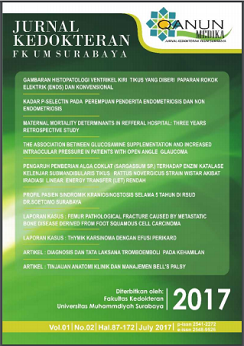The Relationship Between Glucosamine Supplementation and Increased Intraocular Pressure in Patients With Open Angle Glaucoma (at Dr. Wahidin Soediro Husodo Hospital)
Abstract
Introduction and Objective Researchers postulate that excessive deposits of GAG in the trabecular meshwork restrict outflow. Another theory suggests that increased release of GAG into the aqueous causes an osmotic effect, drawing more water into the anterior chamber, thus causing swelling, a decrease in pore size, and eventually increased resistance to outflow.Either of these proposed mechanisms could lead to an increased thickness of the pore lining and/or decreased outflow, resulting in increased intraocular pressure (IOP).
 Methods A total of 13 patients (26 eyes) 6 men, 7 women, with average age 62 years were included in this experimental study. IOP was measured before, on 7th day after they began glucosamine supplementation and after discontinuation. Patients had been selected who established the diagnosis of open-angle glaucoma, willingness to using glucosamine, IOP measurements at least 3 times within 2 years, and no associated changes in glaucoma medications or eye surgery.
Result  Based on the parametric repeat measure general linear model test, the IOP decreased significantly from during glucosamine supplementation to discontinuation of glucosamine.(P= 0,013, or P< 0,05).  The IOP was increased during glucosamine supplementation compared with before glucosamine supplementation, but the difference statistically not significant. (P= 0,527).The IOP decreased after discontinuation compared with before supplementation, but the difference also statistically not significant. (P=1). There was no significant difference between the left and right eyes in each patient.
Â
Â
Â
Â
Â
Â
Full text article
References
ACOTT, T. S. & KELLEY, M. J. 2008. Extracellular matrix in the trabecular meshwork. Exp Eye Res, 86, 543-61.
COVELL LL. Glaucoma induced by systemic steroid therapy. Am J Ophthalmol. 1958;45(1):108-109.
FOX, B. A. & STEPHENS, M. M. 2007. Glucosamine hydrochloride for the treatment of osteoarthritis symptoms. Clin Interv Aging, 2, 599-604.
KNEPPER PA, McLone DG. Glycosaminoglycans and outflow pathways of the eye and brain. Pediatr Neurosci. 1985-1986;12(4-5):240-251
KNEPPER, P. A., GOOSSENS, W., HVIZD, M. & PALMBERG, P. F. 1996. Glycosaminoglycans of the human trabecular meshwork in primary open-angle glaucoma. Invest Ophthalmol Vis Sci, 37, 1360-7.
PESCOSOLIDO, N., CAVALLOTTI, C., RUSCIANO, D. & NEBBIOSO, M. 2012. Trabecular meshwork in normal and pathological eyes. Ultrastruct Pathol, 36, 102-7.
POURNADEALI, K. N. 1999. Glucosamine Sulfate: A Review of Efficacy for the Pharmacy Professional. Int J Pharm Compd, 3, 428-433.
REGINSTER, J. Y., NEUPREZ, A., LECART, M. P., SARLET, N. & BRUYERE, O. 2012. Role of glucosamine in the treatment for osteoarthritis. Rheumatol Int, 32, 2959-67.
SALMON, F. J. 2007. Glaucoma In: RIORDAN-EVA, P. & WHITCHER, J. P. (eds.) Vaughan & Asbury’s General Ophthalmology Seventeenth Edition. New York: McGraw- Hill Companies.
SCHACHTSCHABEL DO, BINNINGER E. Stimulatory effects of ascorbic acid on
hyaluronic acid synthesis of in vitro cultured normal and glaucomatous
trabecular meshwork cells of the human eye. Z Gerontol. 1993;26(4):243-246.
UITTERLINDEN, E. J., JAHR, H., KOEVOET, J. L., JENNISKENS, Y. M., BIERMA-ZEINSTRA, S. M., DEGROOT, J., VERHAAR, J. A., WEINANS, H. & VAN OSCH, G. J. 2006. Glucosamine decreases expression of anabolic and catabolic genes in human osteoarthritic cartilage explants. Osteoarthritis Cartilage, 14, 250-7.
Authors

Qanun Medika by FK UM Surabaya is liscence under Lisensi Creative Commons Atribusi 4.0 Internasional.

